More traffic, more growth—that’s the goal, right?
You're not alone—61% of marketers consider traffic growth their top priority.
Google receives around 8.5 billion searches per day worldwide, and 92.96% of global traffic comes from Google Search, Google Images, and Google Maps.
But it's not like Google is the only way to receive website traffic. There are many proven free methods to increase website traffic.
You are not alone. Lots of marketers struggle to get web traffic.
But here's the good news: Simple things like updating old content can make a huge difference – Brian Dean from Backlinko (not anymore) saw a 22% traffic jump just by updating a single blog post! That's not crazy?
So today’s guide will explore 12 simple tweaks to advanced strategies but data-backed – to help you attract more of the RIGHT visitors to your website. Most of them are free is just a plus point.
1. Content is King (and Queen!)
First thing first.
The phrase "content is king" might seem outdated, but its core message remains relevant.
High-quality, relevant content reigns supreme. Why?
Because people and google like it.
Google and most search engines prioritize websites that offer informative, unique, and engaging content.
More importantly, users always seek content that provides value, answers their questions, and helps them solve problems.
This means that creating content just for the sake of it won't cut it. Instead, Focus on crafting SEO optimized content that is:
- Original and insightful, offering something fresh that users can't find elsewhere.
- Accurate and well-researched, providing credible information that builds trust.
- Engaging and reader-focused, using storytelling techniques and interactive elements to capture attention.
- Optimized for relevant keywords, but in a natural way that prioritizes user experience.
Consider using diverse formats like video, audio, interactive tools, and visual elements to cater to different learning styles and preferences.
Let's move to our next easiest way of increasing website traffic.
2. Quora & Medium: Get Massive Traffic
These 2 publishing platforms can be a win-win thing for new websites with zero traffic.
Your content can be viewed by a 500 million audience.
You heard it right.
Medium and Quora have 500 million monthly users combined, While Quora has 400M itself and Medium has 100M.
I was also afraid to share QNA or blogs through these platforms, but back in 2020, I published my first blog post on Medium and linked my blog posts inside it for referral traffic:
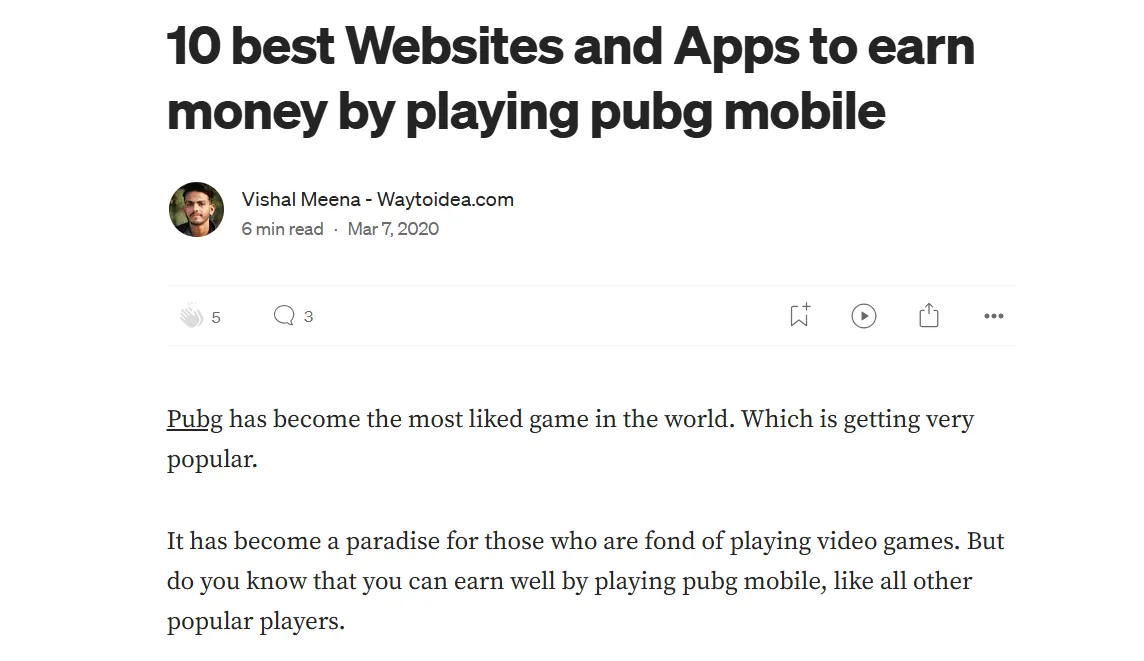
And You know next, my first blog post on Medium was noticed by 34,000 views until today. That gave me thousands of referral traffic from Medium:
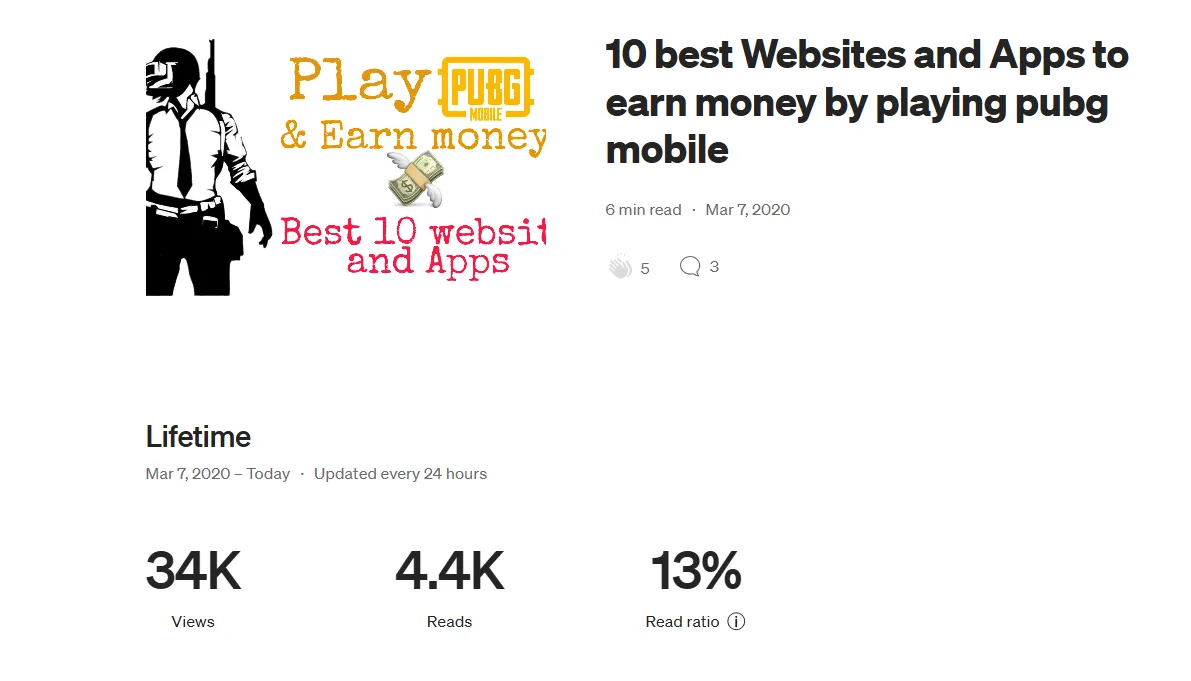
That shows me a significant opportunity.
Here's what I learned and what you need to know to get website traffic from these platforms:
- Target your audience: Identify relevant topics and answer questions thoughtfully to showcase your expertise. Don't forget to research questions that are already ranking high in organic search results.
- Provide value in your answers: Write comprehensive, well-organized, and easy-to-read answers with helpful information, supporting statistics, and relevant images.
- Answer on already ranking articles: To maximize your impact on Quora, focus on questions that are already ranking high in search results. This strategy ensures your answers reach a wider audience organically.
- Don't be afraid to get personal: Medium users love content that shares personal experiences, especially if they are vulnerable and emotionally engaging.
- Partner with publications: Submitting your articles to relevant publications (like pages inside Qoura and Medium) with large followings can significantly expand your reach. Their newsletters and social media promotion can give your article a substantial traffic boost.
See my medium stats for my first blog post, it gets 2400 readers from email newsletters or direct messages only:
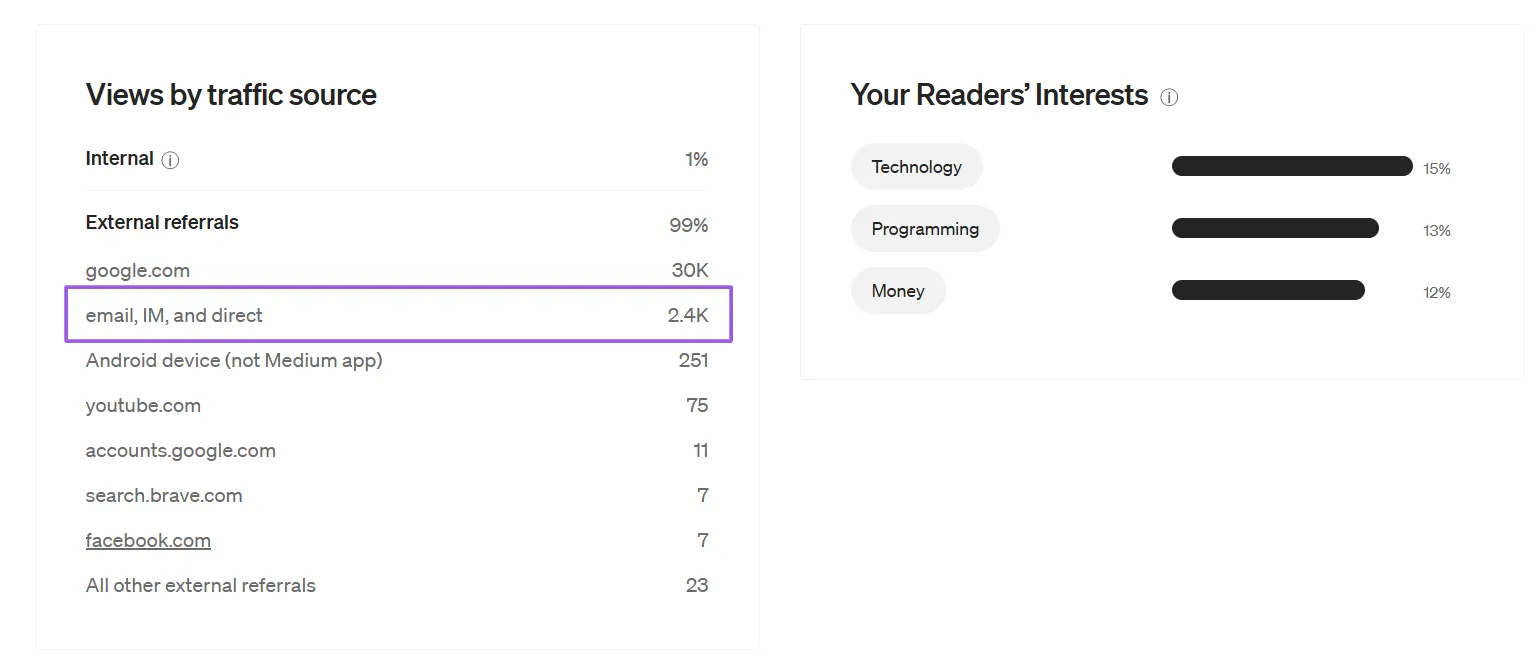
Consistently apply these techniques to both Quora and Medium to drive good traffic to your website.
Pro Tip: Use branded short links in your answers to track traffic back to your website and measure the effectiveness of your strategies.
3. Get Social Media Traffic
A strong social media presence is like a well-maintained highway, smoothly sending traffic to your blog or website.
45% of consumers follow brands for enjoyable content, so encourage your audience to create and share content about your brand, whether it's through contests, giveaways, or simply asking for their experiences. This builds trust and provides you with valuable social proof.
According to the findings of the Search Engine Journal , GrowthBadger , and The Economist , Facebook is the best platform for social media referrals. At the same time, X (formerly Twitter) is also a good start.
Here Open Graph images play a big role.
Make sure your Open Graph image size is relevant for all social media channels, if you don't know it, here is what I am talking about:
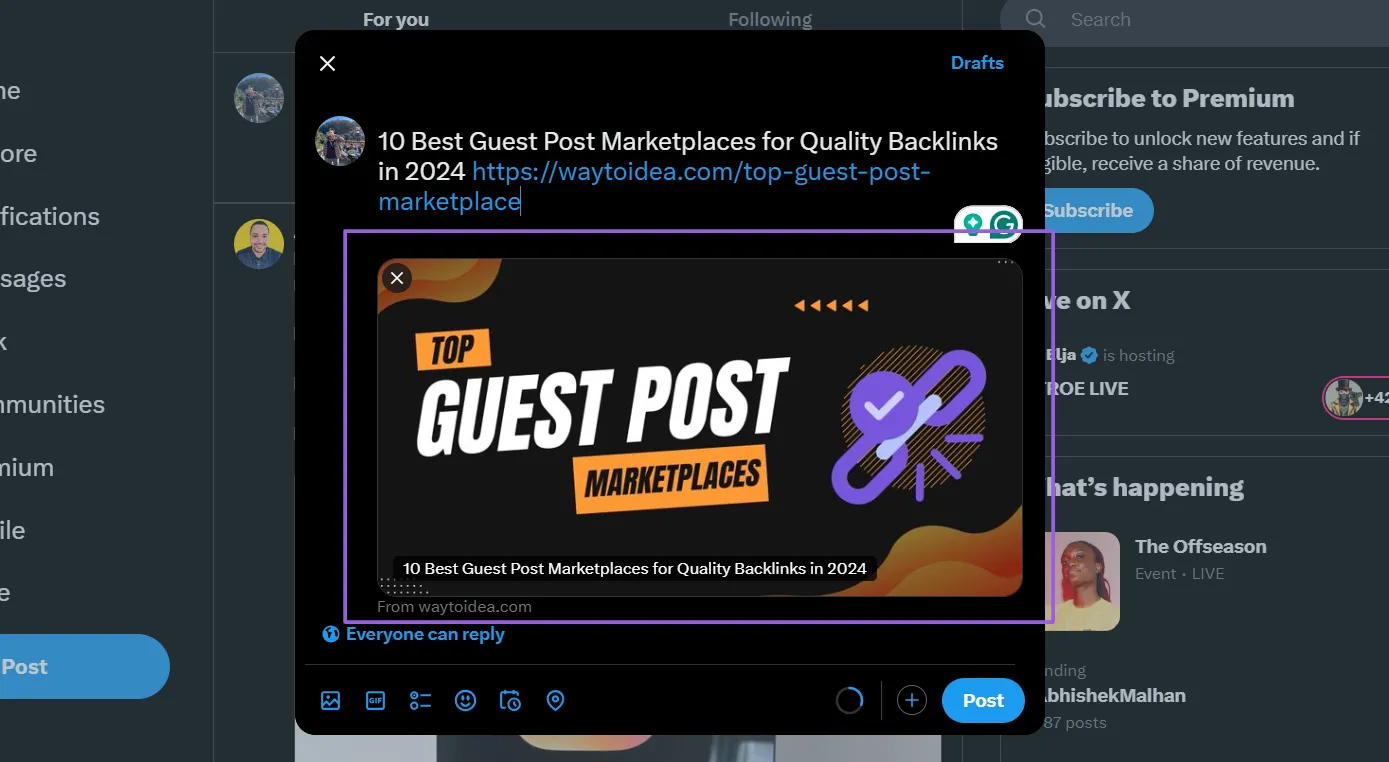
Also, make sure to optimize your social media profiles for search engines by strategically using keywords and hashtags in your bio and posts.
Share high-quality content regularly, Respond to messages, and address customer inquiries efficiently, That's it.
This shows you care about your audience, and you value their time.
Additionally, explore opportunities to connect real-life events to your social media presence.
Create event-specific hashtags, this can help you to go viral.
Partnering with influencers, especially those who have a dedicated following within your target market, can be a powerful way to amplify your reach and drive traffic.
Over 80% of marketers share that influencers are essential to their overall social media strategy.
Finally, streamline your social media efforts by using social media management tools that offer scheduling, analytics tracking, and competitor analysis.
This allows you to focus on creating high-quality content and refining your overall strategy.
4. Guest Blogging
Our next strategy, is one of my favorites, Guest blogging.
Guest blogging is a powerful strategy for driving traffic to your website, building relations, and establishing your brand as an authority in your industry.
Like this:
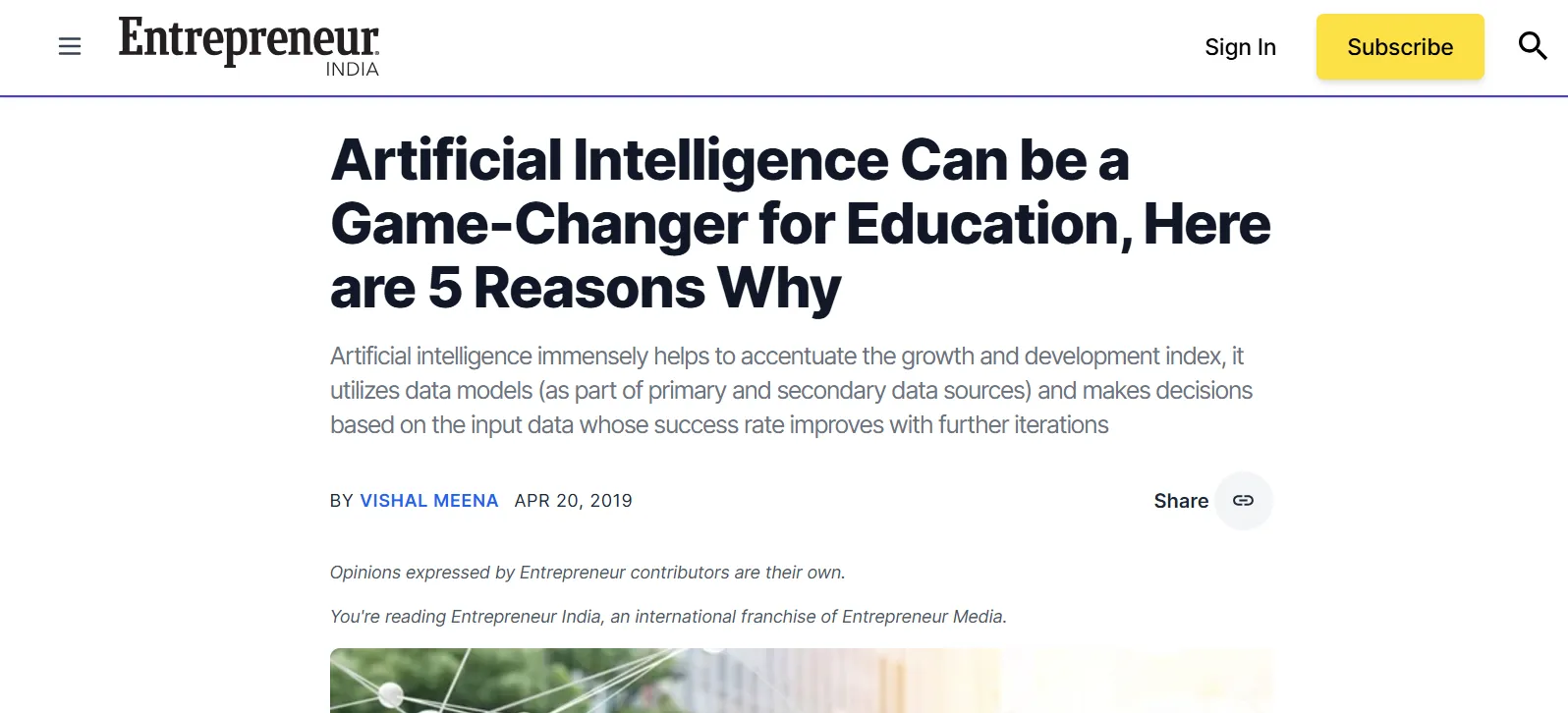
But not limited to, A well-executed guest blogging strategy can lead to:
- Increased website traffic through referral links
- Improved search engine rankings through valuable backlinks
- Enhanced brand awareness and authority
- Opportunities to connect with other industry professional
Guest blogging can be a hard nut to crack because you have to go through a bunch of emails and follow-ups to stand out in their mailbox and get a SUGAR response.
Before pitching for a guest blog post, you research their blog posts that have already been published. Pitch them a unique blog post idea that shares value with the audience.
When you write your guest post, make it top-notch! Stuff it full of value and insights, just like you would for your own blog. And don't forget to sprinkle in some links back to your website (inside content is more recommended than the link in the author bio) - that's how you get people clicking over to your blog.
It's essential to research and identify websites and blogs that align with your target audience, ensuring that your content reaches the right people.
However, here we have a comprehensive list of guest blogging sites in various niches.
You can also find guest blogging sites through various methods:
- Search online directories for websites accepting guest contributions.
- Use specific search commands to find relevant blogs:
- "[Your Niche] + write for us"
- "[Your Niche] + submit guest post"
- Look for "guest posting" or "contributed to" sections in the online profiles of companies and bloggers.
- Consider collaborating with influencers in your niche.
- Create a dedicated page on your website inviting guest contributors.
Guest blogging is a marathon, not a sprint. Keep at it consistently, build relationships with other bloggers, and watch your website traffic soar!
By consistently publishing valuable content on reputable platforms, you can increase your website traffic, enhance your brand's visibility, and foster a loyal following.
5. Dust Off Outdated Content
No one would like to read outdated content, would you?
Keeping your website content fresh and up-to-date is crucial for SEO and, more importantly for your audience to get more returning visitors.
Updating an old blog post doesn't mean replacing the whole content, you just have to go through an editorial process to ensure everything is relevant and shares values.
Search engines favor websites that provide relevant, current information, so refreshing your content can positively impact your search rankings and visibility.
Don't take my word, Orbit Media shares that: Content marketers who dust off their old posts are 2.5x times more likely to see strong results:
Here are several techniques to update old content like a pro:
- Identify outdated blog posts: Look for posts that are no longer performing well or contain information that is no longer accurate.
- Overhaul and upgrade old blog posts: Update outdated information, add new insights, incorporate relevant keywords, and improve the overall readability and visual appeal of your posts. For example, you can add new screenshots, refresh content, and give the post a clearer title.
- Fill content gaps: Use keyword research tools to identify relevant keywords and subtopics that your content may be missing. This will help you create more comprehensive and informative content that addresses user search intent.
- Update visuals: Replace outdated images and screenshots with newer ones to make your content more engaging and visually appealing.
- Republish and re-promote: Treat your refreshed content as new and share it across your social media channels, email lists, and other relevant platforms.
Search engines, and readers, appreciate websites that provide up-to-date, relevant information. Dusting off your old content is a great way to keep your audience engaged and improve your site's visibility.
6. Use Advertising to Increase Web Traffic
Paid traffic allows for quick results, precise audience targeting, and measurable outcomes, when done right, PPC campaigns can deliver good ROI, of up to 200%.
However, it can be expensive, susceptible to ad fatigue and ad blocking, and is dependent on ongoing budget allocation.
While organic traffic is a more cost-effective option that can yield long-term results, it takes time and consistent effort to build. Measuring ROI can also be difficult for organic traffic.
Here are various advertising strategies you can employ:
- Google Ads: This pay-per-click (PPC) advertising platform allows you to bid on keywords related to your business and display your ads at the top of search engine results pages (SERPs).
- Social media advertising: Platforms like Facebook, Instagram, LinkedIn, and Twitter offer targeted advertising options based on demographics, interests, and behaviors, allowing you to reach a highly relevant audience.
- Display advertising: Place banner ads or other visual ads on relevant websites that are related to your target audience.
- Retargeting ads: These ads are displayed to users who have previously visited your website, encouraging them to return and potentially convert.
- Explore lesser-known platforms: Consider advertising on platforms like Quora, Reddit, or TikTok to reach niche audiences and potentially benefit from lower advertising costs.
- Dating apps: If your target audience includes young singles or your brand focuses on relationships, advertising on platforms like Tinder can be effective.
Start with a small budget, test different platforms, and ad formats, then track your results carefully to reach more audience.
Ensure your ads are seen by the right people to maximize your return on investment (ROI).
Experiment with different ad formats, such as search ads, display ads, and retargeting ads, to see what resonates best with your audience.
Retargeting ads, in particular, are a cost-effective way to re-engage visitors who have already shown interest in your website. Remember to carefully monitor your campaign performance and adjust your strategy as needed to maximize ROI.
7. Email Newsletters
To effectively increase website traffic with an email newsletter, build an email list, and consistently provide valuable content, including informative blog posts, how-to guides, ebooks, webinars, and engaging videos.
Offer exclusive discounts, promotions, early access to new products or services, and showcase original user-generated content.
Include signup forms on your website, particularly on high-traffic pages or blog posts for more exposure.
Sender, Brevo, and Mailjet are free mail services to collect emails through newsletters and send emails, you can get started with a free account with some limits.
But here is a catch,
The open rate of emails is between 15% and 25% only across industries. So make sure you optimize email subject lines with compelling language and use clear CTAs to guide subscribers to specific landing pages or blog posts on your website.
You can use clear and enticing CTAs like, Read the full article, Download our free guide, Get your exclusive discount, Register for our upcoming webinar, and more.
Ensure:
- Never spam your subscribers: Focus on providing valuable content and respecting their inboxes.
- Make it easy to unsubscribe: Provide clear instructions on how to opt out of your emails.
8. Search Engine Optimization
Other methods may give you temporary website traffic but SEO will boost your ranking in SERPs.
You can generate substantial traffic from SEO alone.
It's a complex field with many factors to consider, but the core principles are simple: create high-quality content that satisfies user intent, use relevant keywords, and build a technically sound website that is easy for search engines to crawl and index.
SEO is the process of increasing organic traffic through various techniques, including:
- Keyword Research: Keyword research is crucial for any SEO strategy. By using keyword research tools, you can identify the best keywords for your website and create a content strategy that will help you rank higher in search results and attract more website visitors. SEO Tools like SEMrush, Ahrefs, Google Search Console, Moz Keyword Explorer, and Ubersuggest can help you uncover relevant keywords, their search volume, and their competition level.
- On-Page Optimisation: This refers to optimizing elements within your website to make it more appealing to search engines. This includes:
- Content Optimization: Creating high-quality, relevant, and engaging content that includes target keywords naturally.
- Technical SEO: Ensuring your website has a solid technical foundation. This includes optimizing your website's structure, code, and loading speed, ensuring it's mobile-friendly, and using structured data to help search engines understand your content.
- Optimising Meta Description and Title Tag: Crafting compelling meta description and title tag that entice users to click on your website in search results.
- Optimizing URLs: Including target keywords in your URLs to improve relevance and user experience.
- Using Internal Linking: Strategically placing internal links within your content to guide users to other relevant pages on your website and improve site navigation.
- Off-Page Optimization: This involves activities conducted outside your website to build credibility and authority, which can positively influence search engine rankings. This includes:
- Link Building: Earn high-quality backlinks from other reputable websites in your niche.
- Social Media Marketing: Engaging on social media platforms to increase brand visibility, promote content, and drive more traffic to your website.
SEO is not a day game.
It requires continuous monitoring, analysis, and adjustments to stay ahead of Google algorithm updates and maintain optimal search engine rankings.
By investing in SEO, businesses can establish a strong online presence, attract more qualified leads, and achieve sustainable long-term growth.
9. Online Directory Listings
Directories listing is a free method of driving traffic to your website.
Hundreds of directories still attract traffic and offer value to websites and businesses.
Directories such as BOTW, AboutUs, Google Business Profile, and Yelp have gained importance. These platforms allow websites of all types to be submitted and discussed:
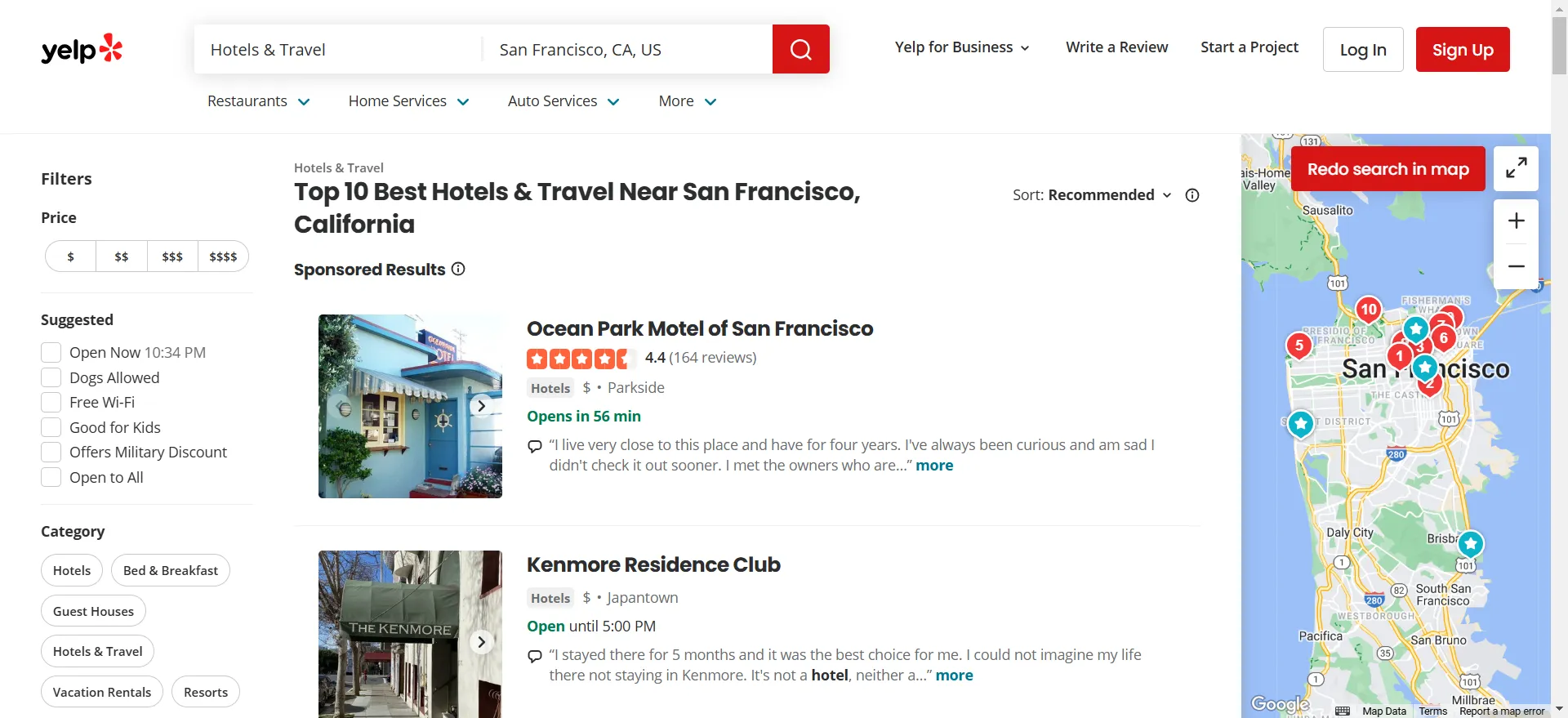
A significant advantage of online directory listings is that many, like Yelp , have strong domain authority on Google, meaning your business’s free page on these sites could rank highly for relevant searches.
They allow you to manage your listings and analyze their performance.
Getting listed in online directories can increase traffic to your website. Your profile on most of these sites will include a link to your website. Actively updating these listings and getting positive reviews will likely increase website traffic.
Online directories can help your business get found when people search for services online. They are particularly beneficial for specific sectors such as healthcare, home services, retail, professional services, travel and entertainment, and multi-location businesses.
💡: Find out Free Directory Submission Sites List.
10. Partner With Other Content Creators
The next method I have used to increase website traffic is to partner with other content creators.
Have you thought about co-hosting blog content? All the things where I’ll go and I’ll create content with other people, and we’ll do it on a similar topic.
So, for example, we may do a joint webinar or a joint podcast. We may even do roundup posts. We may even do interviews with other people.
By partnering with other content creators, you’ll find that they’ll promote the content, and you’ll promote the content as well. But you may be like Vishal, and I don’t have any traffic to my site. That’s okay.
That’s why I also gave you options to interview people and do roundup posts because people are always flattered to be interviewed.
People are always flattered to be included in a roundup post. And you know what, when you have X person in these posts, what are they going to do when it gets published?
They’re going to share it. When they share it on their favorite social site, what happens, your site will get more traffic.
And yeah, you may find that all of the experts may not share the content, but if you email asking them to, a large portion will. I’m talking about 30%, 40% plus.
When people interview me and ask me to share the content, I almost always share it. Giveaways, contests, or promotions.
Look, reach out to other websites in your niche, offer them something valuable to their audience, and they’ll spread the word.
When they do, your website traffic will increase.
11. Use Push Notifications
The next method is push notifications. It’s the simplest way to keep getting more and more traffic. Just think of it this way.
Look, someone comes to your site, are they going to go back? Chances are no.
If you’re not sure about this, check out Google Analytics of the most prominent blogs. There’s a cohort report in there, and it shows you how often people come back.
You’re lucky if three months down the road, even 1% of your audience comes back. By doing those push notifications with one click, someone’s subscribed to your site.
They didn’t have to put in an email or anything, and they didn’t have to give you any of their personal information.
And then any time you release more content, any new features, or promotions, you can message them all out and quickly get them back to your site. And you can increase website traffic.
And you can use Subscribers to do this.
12. Commenting on Other Sites
And the Next method I have for you, comment on other blogs in your industry.
When you comment on these blogs, I’m not just saying leave stuff like, “Nice content!” “Good job!” “Thanks’ etc.
I’m talking about leaving detailed comments that provide readers with feedback.
Now when you leave a comment, right, and people are getting all this advice and feedback from you, when you leave that comment, you’ll find that it’s asking for your name and URL and comment.
You already know what to do in the comment box. Your name is your name. Your URL should be your website URL.
Then, eventually, as people like your comments, they will click on those comments, people will go to your site, and you’ll be getting more traffic to your website.
Do you know about a site called Mashable?
Petes Cashmore, the founder of Mashable, that’s what he did when he first started, that’s how he grew that site in popularity.
Conclusion: Increasing Website Traffic
These wide ranges of strategies for increasing website traffic, encompass both free and paid methods.
There's no magic bullet.
The key takeaway is that a multifaceted approach is most effective, combining different tactics to reach a wider audience and maximize results.
Free Methods:
- Content Marketing: Creating and sharing valuable content that attracts and engages the target audience is crucial. This can include blog content, videos, infographics, and interactive content, all designed to provide information, solve problems, or entertain.
- SEO: This long-term strategy focuses on improving a website's visibility in search engine results pages. It involves keyword research, optimizing website content and structure, building high-quality backlinks, and ensuring a positive user experience.
- Social Media Marketing: Actively engaging on relevant social media platforms can increase brand visibility, promote content, and drive traffic to a website.
- Email Marketing: Building an email list and sending out regular newsletters can nurture relationships with subscribers and drive traffic back to a website.
- Guest Blogging: Writing and publishing articles on other websites in your industry can expose your brand to a new audience and generate referral traffic.
- Online Directory Listings: Getting listed in relevant directories can improve visibility in local searches and drive targeted traffic.
Paid Methods:
- Paid Advertising: Investing in online advertising platforms like Google Ads, social media ads, and display ads can deliver more immediate results and reach a broader audience.
Additional Strategies:
- Refresh and Repurpose Content: Updating existing content and repurposing it into different formats can extend its reach and attract new visitors.
- Collaborations: Partnering with other businesses or influencers can tap into new audiences and generate buzz around your brand.
- Quora & Medium: Participating in forums, online groups, and Q&A platforms like Quora, and Medium can build relationships, establish thought leadership, and drive traffic to your website.
- Host Giveaways and Contests: Offering freebies or running contests can generate excitement, boost social media engagement, and attract new visitors to your website.
By implementing a combination of these strategies, you can establish a strong online presence, attract a steady stream of targeted traffic, and achieve your marketing goals.
Remember to track your website traffic and analyze the performance of different strategies to refine your approach and ensure you're getting the most out of your efforts.
I hope these strategies work for you, See you in the comment section!
Loading comments...


